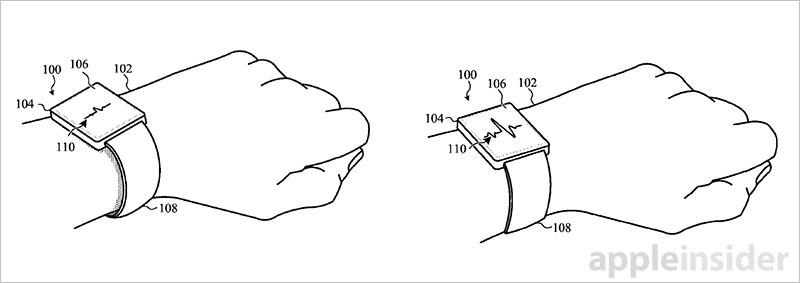Apple investigating self-adjusting Apple Watch bands
Last updated
Apple on Tuesday was granted a U.S. patent describing multiple methods of creating a self-adjusting Apple Watch band, designs that could one day replace magnetic clasps, velcro and other fasteners seen in current generation hardware.
As assigned by the U.S. Patent and Trademark Office, Apple's U.S. Patent No. 9,781,984 for "Dynamic fit adjustment for wearable electronic devices" details methods in which a wearable device, like Apple Watch, can tighten or loosen an attached strap via an onboard tensioner.
Apple in its document notes conventional watch bands are cumbersome, require multiple steps to achieve a desired fit, necessitate specialized tools or are otherwise inconvenient to adjust. Additionally, traditional methods often fail to offer size increments suitable for all users, leading to an imperfect fit.
Aside from being uncomfortable, less than ideal sizing could negatively impact Apple Watch sensor readings, from the bespoke heart rate sensor to data collected by sensitive accelerometers. The effect can become pronounced during exercise, for example, when the device may become loose due to sweat and repeated motion.
To facilitate ease-of-use and device efficiency, Apple proposes a system capable of automatically, or at a user's request, adjusting band sizing through a tensioner mechanism.
The document details a number of potential solutions for system tensioning including embedded shape memory wire, an internal ratcheting apparatus, gas or fluid bladders (standalone or built into the strap), retractable band elements and extendable portions of the device housing. With the latter method, a portion or portions of an Apple Watch chassis, or alternatively its band, extend out toward a user's skin, thereby tightening the band's fit.
Multiple function modes are paired with each tensioning method, the most prevalent being tightening and loosening, or more accurately contracting and expanding. For certain embodiments, specifically those in which a band's material can affect fit, the patent describes flexibility and rigid modes that serve roughly the same purpose as tightening and loosening operations.
In some embodiments, the tensioner mechanism is automatically activated based on a set of predetermined criteria which can include user detection via the biometric sensor stack. Other methods allow for user customization through an onscreen UI. For example, users can select from set fit levels or instruct the device to make its band tighter or looser.
Whether Apple will integrate the technology into a future Apple Watch device remains unknown, but the company continues to roll out new band style, the most recent being the hook-and-loop Sport Loop. With a renewed focus on health and fitness, an automatically adjustable band would be a boon for users looking not only for a better fit, but more accurate sensor readings.
As can be expected, the patent jibes with Apple's current strap offerings. The Sport Band with pin-and-tuck closure can be retrofitted to incorporate an adjustable mechanism in its pin hardware, for example, while woven nylon and metal link designs might benefit from Nitinol wire that tightens or collapses with applied electrical current.
Apple's dynamically adjustable Apple Watch band patent was first applied for in April 2015 and credits Andrzej T. Baranski, Serhan O. Isikman, Tyler S. Bushnell, Steven J. Martisauskas and David I. Nazzaro as its inventors.
 Mikey Campbell
Mikey Campbell
















 Amber Neely
Amber Neely
 Thomas Sibilly
Thomas Sibilly
 AppleInsider Staff
AppleInsider Staff
 William Gallagher
William Gallagher
 Malcolm Owen
Malcolm Owen
 Christine McKee
Christine McKee










13 Comments
Maybe I'm asking for too much, but this is how I'd like Apple's future wearables to self adjust.
https://www.youtube.com/watch?v=7alIF_Ff6L0
Or you could go low-tech. Does anyone remember Speidel Twist-O-Flex bands? Your dad probably had one...
http://www.speidel.com/index.php/00139902.html
Great. This may save Apple employees so much time they can figure out to put the right power adapter in an iPhone box.
"unapologetically elastic" – Future Jony Ive
I would wager that Apple makes more profit off of their AW bands than all other smart watch vendors make in aggregate profit...